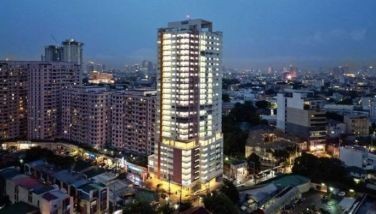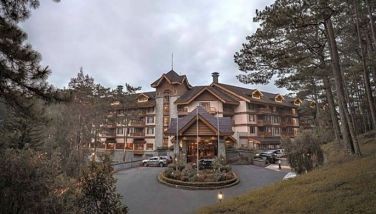Guinsaugon, a year after the tragedy
February 17, 2007 | 12:00am
Exactly a year ago today, massive boulders of rocks and soil covered an entire barangay in St. Bernard town in Southern Leyte, killing at least 100 people and leaving hundreds of families homeless.
But for 23 young survivors, nature's wrath was not enough to destroy their hopes for a better life.
Next month, they will graduate high school and one of them, a 26-year-old girl, even finish at the top 20 of her class. The girl lost her mother and two brothers in the tragedy.
"Sa sugod, naglisod jud ko pero naka-move on ko kay gitabangan ko sa akong mga friends," she told The FREEMAN.
Sister M. Rosario Aya-ay, principal of Cristo Rey Regional High School where the 23 are studying, said the girl is inherently intelligent, and has been very strong in coping with the loss of her family members.
The graduating girl, the principal said, serves as her point-person every time she calls the student-survivors to a meeting. When tragedy struck, the school's 14 students got orphaned, 37 lost either of their parents, and 27 more lost both parents.
Eighteen students who were not residents of barangay Guinsaugon were also affected because their families had to leave their barangays that were adjacent to the unfortunate Guinsaugon.
Cristo Rey Regional High School is located in St. Bernard town proper, a few kilometers away from barangay Guinsaugon.
Aya-ay said the only reason why the students were spared of the tragedy was that they were in school when the landslide hit the town morning of February 17, 2006.
Aya-ay recounted that the students were supposed to go home early that day to prepare for their third periodical examination scheduled the next day.
Concerned that the students could no longer fulfill their homeroom assignments, she decided to just sign their clearances only in the afternoon. It turned out then that the concern on cleanliness was a blessing in disguise.
Fate, however, was not very kind to two other students who eventually suffered the landslide's fury.
One boy felt sick and went home to Guinsaugon while another decided to go back to their house to get his project required for the signing of the clearance. Both rode on the same jeepney that was buried by the avalanche of mud and rocks.
A year had passed since then and now the students could already manage a smile-even croon to some songs, as one plucks the guitar.
While the shock and pain probably subsided, Aya-ay said the pain of loss is apparently buried within them. They described as "crime stones" the rocks they gathered in helping build a chapel near the site of the tragedy.
With financial aid from the Association of Medical Doctors of Asia, and the Association of Medical Students of Asia, together with an architect who designed the structure for free, the school initiated the construction of a chapel.
Surviving families decided to help build the chapel but Aya-ay said the students admitted it was still hard for them to look at the mountain, which the referred to it as the "murderer."
After several months of living in makeshift tents and structures inside the school's premises, the students and the surviving families from barangay Guinsaugon have been relocated to a new site in barangay Magbagakay.
Gawad Kalinga helped build the houses during the first phase of the relocation, the Japanese International Cooperation Agency came for the second phase, and Red Cross helped for the third phase.
The last batch of survivors was transferred to the new relocation sites early this month.
Survivors from neighboring barangays Hinabyan, Magatas, and Kauswagan are dwelling at Catmon Central School while those from barangays Ayahag and Sug-angon are temporarily housed at the St. Bernard Central School.
If one student-survivor getting into the top 20 of this year's graduating class, last year's graduation ceremony was considered more dramatic because both the valedictorian and the salutatorian were survivors of the landslide.
The valedictorialnlost his two sisters while the salutatorian was an evacuee from neighboring barangay Magatas.-/ RAE
But for 23 young survivors, nature's wrath was not enough to destroy their hopes for a better life.
Next month, they will graduate high school and one of them, a 26-year-old girl, even finish at the top 20 of her class. The girl lost her mother and two brothers in the tragedy.
"Sa sugod, naglisod jud ko pero naka-move on ko kay gitabangan ko sa akong mga friends," she told The FREEMAN.
Sister M. Rosario Aya-ay, principal of Cristo Rey Regional High School where the 23 are studying, said the girl is inherently intelligent, and has been very strong in coping with the loss of her family members.
The graduating girl, the principal said, serves as her point-person every time she calls the student-survivors to a meeting. When tragedy struck, the school's 14 students got orphaned, 37 lost either of their parents, and 27 more lost both parents.
Eighteen students who were not residents of barangay Guinsaugon were also affected because their families had to leave their barangays that were adjacent to the unfortunate Guinsaugon.
Cristo Rey Regional High School is located in St. Bernard town proper, a few kilometers away from barangay Guinsaugon.
Aya-ay said the only reason why the students were spared of the tragedy was that they were in school when the landslide hit the town morning of February 17, 2006.
Aya-ay recounted that the students were supposed to go home early that day to prepare for their third periodical examination scheduled the next day.
Concerned that the students could no longer fulfill their homeroom assignments, she decided to just sign their clearances only in the afternoon. It turned out then that the concern on cleanliness was a blessing in disguise.
Fate, however, was not very kind to two other students who eventually suffered the landslide's fury.
One boy felt sick and went home to Guinsaugon while another decided to go back to their house to get his project required for the signing of the clearance. Both rode on the same jeepney that was buried by the avalanche of mud and rocks.
A year had passed since then and now the students could already manage a smile-even croon to some songs, as one plucks the guitar.
While the shock and pain probably subsided, Aya-ay said the pain of loss is apparently buried within them. They described as "crime stones" the rocks they gathered in helping build a chapel near the site of the tragedy.
With financial aid from the Association of Medical Doctors of Asia, and the Association of Medical Students of Asia, together with an architect who designed the structure for free, the school initiated the construction of a chapel.
Surviving families decided to help build the chapel but Aya-ay said the students admitted it was still hard for them to look at the mountain, which the referred to it as the "murderer."
After several months of living in makeshift tents and structures inside the school's premises, the students and the surviving families from barangay Guinsaugon have been relocated to a new site in barangay Magbagakay.
Gawad Kalinga helped build the houses during the first phase of the relocation, the Japanese International Cooperation Agency came for the second phase, and Red Cross helped for the third phase.
The last batch of survivors was transferred to the new relocation sites early this month.
Survivors from neighboring barangays Hinabyan, Magatas, and Kauswagan are dwelling at Catmon Central School while those from barangays Ayahag and Sug-angon are temporarily housed at the St. Bernard Central School.
If one student-survivor getting into the top 20 of this year's graduating class, last year's graduation ceremony was considered more dramatic because both the valedictorian and the salutatorian were survivors of the landslide.
The valedictorialnlost his two sisters while the salutatorian was an evacuee from neighboring barangay Magatas.-/ RAE
BrandSpace Articles
<
>
- Latest
- Trending
Trending
Latest

























